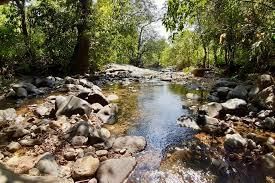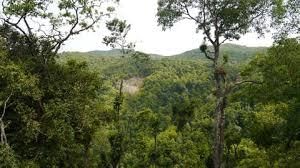GPSC (Goa) Exam > GPSC (Goa) Notes > Goa State PSC (GPSC) Preparation > Goa: Vegetation
Goa: Vegetation | Goa State PSC (GPSC) Preparation - GPSC (Goa) PDF Download
| Table of contents |

|
| Biodiversity of Goa |

|
| Forest and Vegetation of Goa |

|
| Plateau Vegetation of Goa along Undulating Terrain and Hills |

|
| Semi-evergreen and evergreen Vegetation of Goa along upper ghats |

|
Biodiversity of Goa

- The term biodiversity refers to the immense variety of life forms existing on Earth.
- Approximately 1.8 million distinct species have been cataloged by various communities including tribal groups, farmers, and scientists.
- Well-studied organisms include around 8,600 bird species, 4,000 mammal species, and 32,000 flowering plant species.
- However, there remains uncertainty regarding less studied organisms like insects, fungi, and various microorganisms.
- The estimated total number of species on the planet is at least eight million and likely more, emphasizing the ongoing need for research and classification efforts.
- Enhancing our understanding of the diverse organisms that coexist on Earth stands as a significant challenge for the modern era.
Forest and Vegetation of Goa
- The forests found in Goa are representative of the Western Ghats region, which includes parts of Southern Maharashtra and Karnataka.
- Diversity in the forests is observed due to variations in factors like altitude, aspect, soil composition, and slope.
- Specific Categories of Vegetation:
- Estuarine Vegetation: This type is characterized by mangrove species thriving along narrow muddy banks of rivers.
- Strand Vegetation: Along the coastal areas, vegetation specific to these regions is found.
- Plateau Vegetation: Vegetation primarily found at lower altitudes on plateaus.
- Open Scrub Jungle: Areas with scattered bushes and shrubs.
- Moist Mixed Deciduous Forests: Forests with a mix of deciduous trees with high moisture content.
- Secondary Moist Mixed Deciduous Forests: Younger versions of mixed deciduous forests.
- Sub-tropical Hill Forests: Forests found in hilly regions with sub-tropical characteristics.
- Semi-evergreen and Evergreen Forests: Patches of forests with trees retaining leaves throughout the year.
- Semi-evergreen Forests: Forests with trees that shed a portion of their leaves seasonally.
- Lateritic Semi-evergreen Forests: A specific type of semi-evergreen forest found on laterite soil.
- Evergreen Forests: Forests with trees that remain green throughout the year.
Estuarine Vegetation of Goa of mangroves along swampy river banks
- These mangroves exist in small patches along the banks of Mandovi and Zuari rivers as well as other saltwater streams.
- Characterized by unique root formations such as stilt roots of Rhizophora, pneumatophores in Avicennia, and knee roots in Bruguiera.
- Major locations include Durbhat, Panaji, Agassaim, and Cortalim.
- Found at elevations ranging from sea level to 100m.
Strand and Creek Vegetation along the Coastal Belt
- Coastal areas of Goa primarily feature rocky terrain with projecting ridges.
- Strand vegetation is limited to narrow strips along the Arabian Sea coast.
- Notable tree species in this zone are Pongamia pinnata, Thespesia pupulnea, Calophyllum inophyllum, Cerbera manghas, and Pandanus tectorius.
- Various herbaceous species like Neanotis rheedei, Iphigenia indica, Begonia crenata, Mitreola oldenlandioides, Habenaria grandifloriformis, Tricholepis glaberrima, and Trichidesma sp. thrive along rocky creeks and ridges facing the coast.
Question for Goa: VegetationTry yourself: Which vegetation type is characterized by mangrove species thriving along narrow muddy banks of rivers?View Solution
Plateau Vegetation of Goa along Undulating Terrain and Hills

The plateau vegetation of Goa, spread across undulating terrain and hills, primarily consists of two main types: open scrub jungle and moist deciduous forests.
Open Scrub Jungle
- This type of vegetation is predominant in various regions of Goa, stretching from Panaji to Cortalim and from Bicholim to Sanquelim.
- Anacardium occidentale, commonly known as cashew, is a prominent species found extensively in this type of vegetation.
- The vegetation in this category is largely characterized by dry deciduous elements, including plants like Carissa congesta, Hollarrhena pubescens, Lantana camara, Calycopteris floribunda, Woodfordia fruticosa, Grewia abutilifolia, Vitex negundo, and various species of Calotropis, Ziziphus, Cassia, Ixora, Acacia, Albizia, Terminalia, and Crotalaria.
Moist Mixed Deciduous Forests
- Moist mixed deciduous forests cover more than half of the forest areas in Goa.
- In the North Goa Division, this forest type can be found around Tudal, Ordofind, Butpal, Molem, Codal, Abiche Gol near Valpoi, and Anmode ghat.
- Predominant species in these forests include Terminalia crenulata, T. belerica, T. paniculata, Lagerstroemia parviflora, Adina cordifolia, Albizia lebbeck, A. procera, Mitragyna parvifolia, Holoptelia integrifolia, Trewia nudiflora, Dillenia pentagyna, Semicarpus anacardium, Mallotus philippensis, and Stereospermum colais.
Sub-tropical Hill Forests
- These forests have developed from historical "Kumeri" cultivation.
- Commonly found species include Syzygium cuminii and Cinnamomum verum.
- Caryota urens stands out as the most prevalent palm species in this forest type.
- In the second layer, Carvia callosa (Strobilanthes callosus), Elaeagnus conferta, and Capparis spp. are typically present.
Semi-evergreen and evergreen Vegetation of Goa along upper ghats
Semi-evergreen forests
- These forests in Goa are a mix of tropical evergreen and moist deciduous varieties, typically located at elevations above 500 meters in areas such as Ambochegol, Molem, Butpal, and Nadquem.
- The species makeup includes Artocarpus hirsutus, A. gomezianus, Calophyllum spp., Sterculia guttata, Kydia calycina, Lagerstroemia microcarpa, Pterospermum diversifolium, Garcinia indica, Diospyros Montana, and Macranga peltata.
Lateritic Semi-evergreen Forests
- These forests thrive on shallow, dry lateritic soils and feature important tree species such as Xylia xylocarpa.
- Other notable associates include Pterocarpus marsupium, Grewia tiliifolia, Terminalia paniculata, Schleichera oleosa, Careya arborea, Bridelia retusa, and Strychnos nux-vomica.
Evergreen Forests
- This particular forest type is typically located in deep gorges, depressions, and alongside streams and water bodies within the Ponda-Amboli-Rambhat region.
- It hosts a variety of plant species such as Calophyllum calaba, Garcinia gummi-gutta, Canarium strictum, Lophopetalum wightianum, Myristica spp., Knema attenuata, Chroisophyllum acuminata, Palaquium ellipticum, Artocarpus gomezians, Diospyrus ebenum, Mangifera indica, Persea Macrantha, Mimusops elengi, Hopea ponga, Olea dioica, Hydnocarpus pentendra, Syzygium cumini, Holigarna arnotiana, Litsea coriacea, Carallia brachiata, Mallotus philipprnsis, Ficus spp., and more.
- Additionally, Osmunda regilis, also known as the royal fern and a rare species in peninsular India, can be found within this specific forest type.
The document Goa: Vegetation | Goa State PSC (GPSC) Preparation - GPSC (Goa) is a part of the GPSC (Goa) Course Goa State PSC (GPSC) Preparation.
All you need of GPSC (Goa) at this link: GPSC (Goa)
FAQs on Goa: Vegetation - Goa State PSC (GPSC) Preparation - GPSC (Goa)
| 1. What is the significance of the biodiversity of Goa? |  |
Ans. The biodiversity of Goa plays a crucial role in maintaining the ecological balance, supporting various plant and animal species, and providing important ecosystem services such as water purification and climate regulation.
| 2. What types of vegetation can be found in the plateau areas of Goa? |  |
Ans. The plateau areas of Goa are characterized by diverse vegetation, including grasslands, shrublands, and patches of deciduous forests. These areas support a variety of plant and animal species adapted to the dry and rocky terrain.
| 3. How does the semi-evergreen and evergreen vegetation in the upper ghats of Goa contribute to the region's biodiversity? |  |
Ans. The semi-evergreen and evergreen vegetation in the upper ghats of Goa are rich in plant diversity and provide habitats for a wide range of species, including rare and endemic plants. These forests also help in maintaining soil fertility and regulating water flow in the region.
| 4. What are some of the threats to the forest and vegetation of Goa? |  |
Ans. Some of the threats to the forest and vegetation of Goa include deforestation, habitat loss due to urbanization and agricultural expansion, invasive species, and climate change. These factors can lead to a decline in biodiversity and ecosystem health in the region.
| 5. How can conservation efforts help protect the biodiversity of Goa? |  |
Ans. Conservation efforts such as protected area management, reforestation, sustainable land use practices, and community-based conservation initiatives can help protect the biodiversity of Goa. These efforts can help preserve important habitats and species, promote sustainable development, and ensure the long-term health of the region's ecosystems.
Related Searches



















